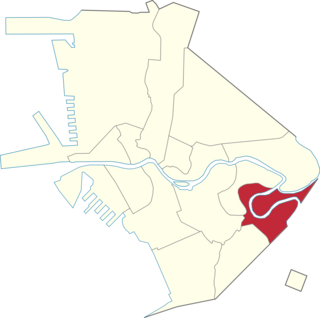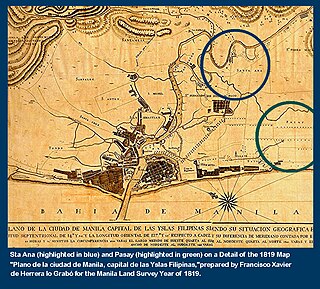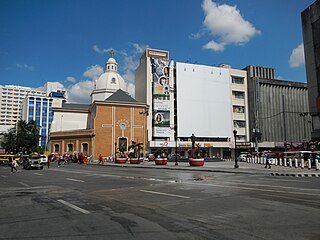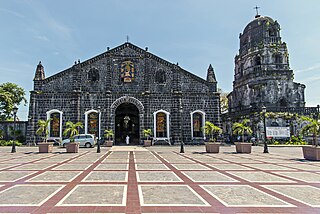Related Research Articles

The Pasig River is a water body in the Philippines that connects Laguna de Bay to Manila Bay. Stretching for 25.2 kilometers (15.7 mi), it bisects the Philippine capital of Manila and its surrounding urban area into northern and southern halves. Its major tributaries are the Marikina River and San Juan River. The total drainage basin of the Pasig River, including the basin of Laguna de Bay, covers 4,678 square kilometers (1,806 sq mi).

San Juan, officially the City of San Juan, is a 1st class highly urbanized city in the National Capital Region of the Philippines. According to the 2020 census, it has a population of 126,347 people. It is geographically located at Metro Manila's approximate center and is also the country's smallest city in terms of land area.

Santa Mesa is a district in Manila, Philippines. It is surrounded by the Pasig River on the southwestern side, and by the San Juan River on its southern and eastern side. Land borders include the districts of San Miguel to the west and Sampaloc to the north; and to the northeast is Quezon City.

Doroteo Jose station is an elevated Light Rail Transit (LRT) station located on the LRT Line 1 (LRT-1) system in Santa Cruz, Manila. The station is situated on Rizal Avenue and slightly past Doroteo Jose Street. Both the station and the street are named after Doroteo Jose, a Filipino who was arrested by Spanish authorities in 1898 for leading a movement against a corrupt archbishop.

Santa Ana is a district in the City of Manila, Philippines. It is located on the city's southeast, bordering the cities of Mandaluyong and Makati in the east, the city districts of Paco and Pandacan in the west, and Santa Mesa in the north. It is part of the 6th congressional district of Manila, with thirty-five barangays. Based on the 2020 national census, the Philippine Statistics Authority reports that the district has a population of 203,598.

Santa Cruz is a district in the northern part of the City of Manila, Philippines, located on the right bank of the Pasig River near its mouth, bordered by the districts of Tondo, Binondo, Quiapo, and Sampaloc, as well as the areas of Grace Park and Barrio San Jose in Caloocan and the district of La Loma in Quezon City. The district belongs to the 3rd congressional district of Manila.

Namayan, also called Sapa, Maysapan, and sometimes Lamayan, was an independent indigenous polity on the banks of the Pasig River in the Philippines. It is believed to have achieved its peak in 1175, and to have gone into decline sometime in the 13th century, although it continued to be inhabited until the arrival of European colonizers in the 1570s.
Bulacan is a province of the Philippines. It was established on 15 August 1578.

The Metropolitan Waterworks and Sewerage System, formerly known as the National Waterworks and Sewerage System Authority (NAWASA), is the government agency that is in charge of water privatization in Metro Manila and nearby provinces of Cavite and Rizal in the Philippines. It split the water concession into an east and a west concession with Manila Water being awarded one contract and Maynilad Water Services being awarded the other.

The Battle of Manila of 1896 occurred in Manila in the Spanish colony of the Philippines during the Philippine Revolution. Katipunan under Andres Bonifacio attempted to take the city but the attempt failed, and Bonifacio retreated to the city's outskirts. The Battle of San Juan del Monte was joined a day later when Bonifacio attempted to capture the San Juan's powder magazine, but this too failed.

Plaza Lacson, also known by its old name, Plaza (de) Goiti, is a public square in Santa Cruz, Manila. It is bounded by Plaza Santa Cruz Road and Escolta Street to the west, Carlos Palanca Street to the south, and Carriedo Street to the east. Although the plaza is not considered the center of Santa Cruz, as it is located behind the Santa Cruz Church rather than in front of it, the plaza is considered to be one of the most important squares in Manila.

The National Shrine of Our Lady of the Abandoned, also known as the Santa Ana Church, is a Spanish colonial period church located in the district of Santa Ana in Manila, Philippines. The parish was established by the Franciscan missionaries in 1578 under the patronage of Saint Anne. The present stone church was constructed by Vicente Inglés from 1720 to 1725 and was dedicated to its present patron, the Our Lady of the Abandoned. The revered image of its patron was made in Valencia, Spain in 1713 and arrived in the Philippines in 1717.

The Don Roman Santos Building is a neoclassical building located along the historic Escolta Street in Santa Cruz, Manila, Philippines. It fronts Plaza Lacson which leads to directly to Carriedo Street or to Rizal Avenue. It was built in 1894 and expanded in 1957.

The Church of Pila,also known as the San Antonio de Padua Parish Church, is a Roman Catholic church dedicated to Saint Anthony of Padua in the Philippines in 1578 and the first Antonine parish church in the Philippines in 1581 and probably in Asia. It is also designated as the National Shrine of San Antonio de Padua of the Catholic Bishops' Conference of the Philippines on April 23, 2019. In 1606 the Franciscans set up the second printing press of the Philippines under the supervision of Tomás Pinpín and Domingo Loag. Its titular is Anthony of Padua, whose feast is celebrated every June 13.

Carriedo Fountain is a fountain in Santa Cruz, Manila, Philippines. It was built in honor of the 18th-century Capitán General of Manila, Don Francisco Carriedo y Peredo, benefactor of Manila's pipe water system. It was moved three times before its current location at Plaza Santa Cruz, right in front of the Santa Cruz Church.

The San Sebastian Parish Church, informally known as Lumban Church, is the only Roman Catholic church in Lumban, Laguna, Philippines. Its titular is St. Sebastian and its feast is celebrated every January 20. The first tabernacle outside Manila was inaugurated in Lumban including the first Eucharistic Procession outside of Manila. The Franciscans established the first School for Church Music in the country in this town under Juan de Santa Maria. Today, the church is under the pastoral care of the Clerical Congregation of the Missionaries of Faith.

The Nuestra Señora de Candelaria Parish Church informally known as Mabitac Church is a Roman Catholic church located above Calvary or Kalbaryo Hill in Mabitac, Laguna, Philippines. Its church is known for having a staircase of 126 steps, a panoramic view of the town of Sta. Maria and Laguna lake, and the festivity of the Three Kings every January 6, a re-enactment of the Magi's journey.

The Saint John the Baptist Parish Church, commonly known as Tabaco Church, is a Roman Catholic church in the city of Tabaco, Albay, Philippines under the jurisdiction of the Roman Catholic Diocese of Legazpi.

The El Deposito is an old underground water reservoir in the city of San Juan in Metro Manila, Philippines. It was built by the Spanish authorities in 1882 with a capacity of 15 million gallons to provide the residents of Manila and its surrounding areas with an adequate water supply. The reservoir was historically known as the site where the onset of the Philippine Revolution through the Battle of San Juan del Monte took place in 1896.
Francisco Carriedo y Peredo was a Cantabrian military officer, politician, and philanthropist. He was a general of the Santa Familia galleon and served as Capitán General of the Philippines.
References
- ↑ Philippine Commission (1900–1916), United States (1905). Report of the Philippine Commission to the Secretary of War. U.S. War Office.
{{cite book}}: CS1 maint: numeric names: authors list (link) - ↑ Jimenez, F. R. (2013-04-13). "Sino si Felix Huerta at bakit ipinangalan sa kanya ang isang kalye sa Sta Cruz area?" [Who is Felix Huerta and why is a street in the Sta Cruz area named after him?]. GMA News and Public Affairs (in Tagalog). Retrieved 2020-05-25.
- ↑ Medina, Marielle (2017-08-02). "Did You Know: Oldest Saving Bank in PH". Inquirer.net. Retrieved 2020-05-25.
- ↑ Yu, Anson (2019-04-02). "To quench a city's thirst". Fortnightly Tulay Chinese Filipino Digest. Archived from the original on 2019-06-18. Retrieved 2020-05-25.
- 1 2 3 4 "Fr. Felix Huerta: Great Benefactor". With One's Past. June 1, 2014.
- ↑ Martinez, Glenn (2008-03-04). "The Carriedo Legacy and the Twin Fountains". Traveler on Foot: A Travel Journal. Retrieved September 15, 2014.